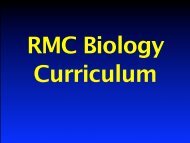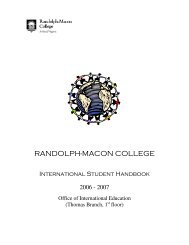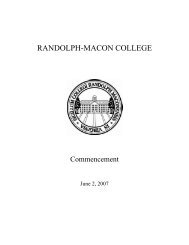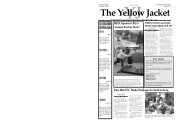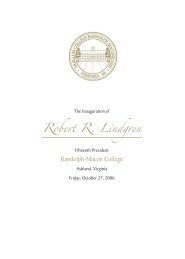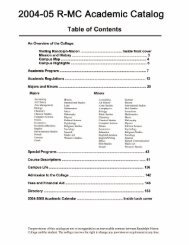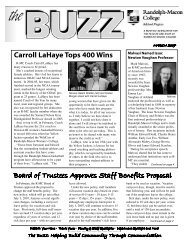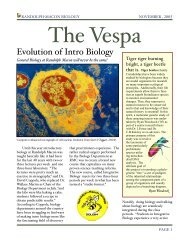Vespa January_2007 - Randolph-Macon College
Vespa January_2007 - Randolph-Macon College
Vespa January_2007 - Randolph-Macon College
Create successful ePaper yourself
Turn your PDF publications into a flip-book with our unique Google optimized e-Paper software.
RANDOLPH-MACON BIOLOGY JANUARY, <strong>2007</strong><br />
The <strong>Vespa</strong><br />
R-MC research gets focused.<br />
Major Research Instrumentation grant !om the National Science<br />
Foundation a#ows purchase of state of the art microscope.<br />
The confocal microscope was used to locate three different proteins simultaneously in each<br />
of these developing !uit fly embryos. Each protein was labeled with a different colored<br />
dye (red, green, or blue), and places where two or more proteins overlap are indicated by<br />
colors such as purple and ye#ow.<br />
Researchers at R-MC are now<br />
able to obtain high resolution 3-D<br />
images of living cells thanks to the<br />
installation of a new Olympus<br />
FluoView FV1000 confocal<br />
microscope earlier this month.<br />
This highly specialized microscope<br />
was purchased with a $260,000<br />
grant from the National Science<br />
Foundation. The grant was c0-<br />
authored by a team from the R-<br />
MC Biology Department and<br />
Kelly Lambert from Psychology.<br />
Confocal technology is one of<br />
the most powerful advances ever<br />
For water fleas it’s<br />
boom or bust!<br />
Students in Integrative Biology<br />
learn about population dynamics<br />
by studying tiny invertebrates.<br />
Daphnia, also known as<br />
water fleas, are not actually fleas<br />
(an insect) at all but rather tiny<br />
aquatic crustaceans like crabs or<br />
lobsters. There are over 150 species<br />
of Daphnia in North America<br />
alone, with many more world<br />
wide. All live in freshwater where<br />
they play a key role in aquatic<br />
food webs, acting as a food<br />
sources for larger animals. Besides<br />
being interesting in<br />
their own right,<br />
Daphnia are a<br />
good organism<br />
for population<br />
studies because<br />
of their<br />
interesting<br />
method of<br />
reproduction<br />
called parthenogenesis.<br />
When there<br />
is plenty<br />
of food<br />
available,<br />
all the Daphnia in the<br />
popula- tion are females<br />
which produce eggs that hatch<br />
without being fertilized, each an<br />
identical clone of the mother.<br />
This aspect of their natural history,<br />
along with their short generation<br />
time, simplifies studies of the<br />
factors that influence birth and<br />
death rates. Once students grasp<br />
the basics of population growth in<br />
Daphnia, they gain a new prospective<br />
on human populations including<br />
such topics as the Earth’s carrying<br />
capacity.<br />
PAGE 1
RANDOLPH-MACON BIOLOGY JANUARY, <strong>2007</strong><br />
developed in microscopy because<br />
it permits scientists to clearly<br />
visualize specific molecules within<br />
a cell and follow their movement<br />
over time. One of the amazing<br />
benefits of the instrument is its<br />
ability to take a series of optical<br />
sections through living cells, which<br />
can then be stacked together to<br />
produce a 3-D image. Together,<br />
these cutting-edge technologies<br />
give researchers a better<br />
understanding of how proteins<br />
actually function within a living<br />
cell.<br />
The new microscope will significantly<br />
boost research capabilities<br />
at R-MC. Among the researchers<br />
taking advantage of the equipment<br />
will be cell biologist Jim Foster<br />
who plans to use the microscope<br />
to learn more about the specific<br />
proteins required for fertilization.<br />
Students will also benefit from<br />
this technology; in fact, R-MC Biology<br />
student Sara Tittermary, a<br />
junior, already has plans to use the<br />
confocal microscope in her independent<br />
study to examine how<br />
mutant proteins are linked to leukemia.<br />
Access to equipment like the<br />
confocal microscope is extremely<br />
rare for undergraduate students at<br />
institutions of any size. According<br />
to David Coppola, department<br />
chair and principal investigator for<br />
this NSF grant, “Confocal microscopes<br />
are usually associated with<br />
major research universities; the<br />
grant from the National Science<br />
Foundation allowing us to obtain<br />
one for <strong>Randolph</strong>-<strong>Macon</strong> is a<br />
stunning affirmation by science<br />
policy makers of our efforts to involve<br />
undergraduates in independent<br />
research.”<br />
Traci Stevens<br />
Assistant Professor of Biology<br />
WHAT SHOULD<br />
PREMEDICAL STUDENTS<br />
MAJOR IN <br />
The answer is simple: major in<br />
anything you want! Medical<br />
schools evince no preference for<br />
the undergraduate major of their<br />
applicants, though there are<br />
required undergraduate courses in<br />
biology, physics, chemistry, math<br />
and English. But, does one major<br />
or another give you a better<br />
chance at getting into med school<br />
One might conclude that ‘major<br />
matters’ based on the most recent<br />
data from the American Association<br />
of Medical Schools, an organization<br />
that represents the 125 accredited<br />
MD granting US med schools.<br />
Perhaps surprisingly, the<br />
percentage of humanities<br />
applicants accepted to med school<br />
exceeded other disciplines in<br />
2006. Does this mean you should<br />
major in English or Philosophy if<br />
you want to get in med school<br />
Not really. It is clear that the<br />
relationship between<br />
undergraduate major and the<br />
slight differences in acceptance<br />
rate suggest a correlation not<br />
causation. In 2006 only 4% of<br />
those accepted to med school<br />
majored in humanities disciplines<br />
as undergraduates! And what was<br />
the most popular undergraduate<br />
major for future ‘saw bones’ You<br />
guessed it: biology. In 2006, 54%<br />
of those attending med school<br />
were biology majors with no other<br />
single discipline exceeding 20%.<br />
Nor does double majoring provide<br />
any advantage according to Vault<br />
Guide to Medical School Admissions<br />
2006. Thus, the best advice<br />
remains ‘follow your heart’ when it<br />
comes to your undergraduate<br />
major...and chill out!<br />
PI IN THE EYE<br />
Research team finds a mathematical<br />
constant in organization<br />
of visual brain. Biological systems<br />
tend to be too complicated to<br />
be described by deterministic<br />
mathematical models. Imagine an<br />
equation that describes the intricacies<br />
of the branching pattern of<br />
your average oak tree, for example.<br />
However, recently Dr. Coppola<br />
and his collaborators at Duke<br />
University and the Max Plank<br />
Institute, Gottingen, have demonstrated<br />
a set of universal quantitative<br />
laws that constrain the layout<br />
of a part of the mammalian brain<br />
that processes visual information.<br />
The clearest signature of these<br />
quantitative laws is that the density<br />
of certain characteristic features<br />
of the functional units in<br />
‘primary visual cortex’ are constrained<br />
to a spatial density of the<br />
mathematical constant pi for each<br />
unit. Amazingly this constraint<br />
was found in three different<br />
mammal species that diverged<br />
>50 million years ago. The study<br />
leader Matthias Kaschube, now at<br />
Princeton, points out that the brain<br />
is sufficiently complicated that it<br />
would take more than 10 12 instructions<br />
to specify it, yet the<br />
human genome, for example, has<br />
fewer than 10 5 genes. One solution<br />
to this conundrum is that<br />
complex biological systems, like<br />
the brain, are ‘self-organizing.’<br />
The ‘Pi principal’ that Kaschube,<br />
Coppola and their colleagues have<br />
discovered provides compelling<br />
evidence for this self organization.<br />
PAGE 2
RANDOLPH-MACON BIOLOGY JANUARY, <strong>2007</strong><br />
DREAMS OF PARADISE...PARADISE<br />
BIRDS THAT IS!<br />
Dr. Russ Shea’s research reminds us of Langston<br />
Hughs’ poignant admonition “Hold fast to dreams<br />
for when dreams die life is a bird that cannot fly.”<br />
However, Russ’ dreams, of late, involve birds that<br />
cannot fly...because they’re stuffed, like the Bird of<br />
Pardadise he is holding in the above photograph.<br />
Midway through his graduate training in<br />
oceanography, Russ found himself spending his off<br />
time on oceanographic cruises watching seabirds.<br />
He wondered how they managed to find the same<br />
patches of food in an otherwise biological desert –<br />
the tropical Pacific Ocean. These observations led<br />
him in an entirely different direction pursuing his<br />
Ph.D. “I was all set to go to the University of Hawaii<br />
to work on a Ph.D. in biological oceanography when<br />
I decided I didn’t like all the time I was spending<br />
away from home on ships – I wanted a land-based<br />
job working on seabirds.” Ultimately he matriculated<br />
to the University of Pennsylvania to work under the<br />
renowned ecologist, Bob Ricklefs. His research<br />
involved problems of growth in tropical seabirds for<br />
which he spent several years working with his wife<br />
and students on Midway Island in the Pacific. In<br />
general, regardless of taxonomic affinity, seabirds<br />
grow very slowly, have one-egg clutches, live a long<br />
time, and mature at a very late age. The evolution of<br />
these life history traits in general, and especially the<br />
evolution of slow growth, has dominated Dr. Shea’s<br />
research interests for the past 30 years, work<br />
supported over the years by the National Science<br />
Foundation and published in premier scientific<br />
journals.<br />
Recently, Russ has been involved in a four-year,<br />
multi-million dollar NSF grant (involving six institutions)<br />
investigating the intersection of physiology<br />
and life history theory in tropical and temperate passerine<br />
birds. According to Shea, “Species differ<br />
widely in rates of reproduction, age at maturity, and<br />
longevity. This variation partly reflects differences in<br />
the environment, but adaptive physiological responses<br />
also influence life history traits.” A fundamental<br />
principle of life history studies is that responses<br />
of individuals and populations to their surroundings<br />
are constrained. Says Shea, “Time, resources,<br />
and body tissues, are limited and must be<br />
allocated optimally among different functions. The<br />
form and functioning of mature individuals reflect<br />
developmental limitations on constructing complex<br />
nervous systems, accumulating experience, and<br />
building immune system defenses.” In this grant,<br />
Shea and his colleagues compare passerines in contrasting<br />
environments (Panama and Michigan) to<br />
address physiological mechanisms associated with<br />
variation in adult survival and related life history<br />
variables. Shea points out that, “In general, birds live<br />
longer in the tropics than at temperate latitudes. Life<br />
history theory suggests that high adult survival rates<br />
and longer<br />
breeding seasons<br />
typical of<br />
tropical environments<br />
select<br />
for a slower<br />
pace of life and<br />
delayed senescence,<br />
to ensure<br />
that the<br />
individual can<br />
realize its potential<br />
longevity. Accordingly, they predict that such<br />
‘slow’ species will exhibit reduced metabolic intensity,<br />
highly developed immune responses, strong responses<br />
against reactive forms of oxygen, year-round<br />
low levels of steroid hormones, and high sensitivity<br />
to environmental stress. Together these traits make<br />
up a syndrome of low reproductive investment and<br />
high self-maintenance, contrasting with opposite<br />
traits of ‘fast’ species at the other end of the life his-<br />
PAGE 3
RANDOLPH-MACON BIOLOGY JANUARY, <strong>2007</strong><br />
tory spectrum (passerines in the temperate zone).”<br />
So far, approximately 50 papers have resulted from<br />
this project which began in 2002. The research team<br />
is currently in the last year of the grant and starting<br />
to write the most important synthetic papers showing<br />
how physiology and behavior constrain life histories.<br />
Results from work estimating the proportion of<br />
young birds in museum colonies (thus the picture<br />
above), that support the grand hypothesis, will be<br />
published this summer in the prestigious journal<br />
Ecology. Indeed dreams are alive for Russ Shea...and<br />
they have taken flight!<br />
• Dr. David Coppola, Chris Waggener and Nicole Phillips<br />
(RMC ‘06) presented a paper in November at the Society<br />
for Neuroscience meeting in Atlanta entitled: “Naris occlusion<br />
alters the magnitude and polarity of the EOG in<br />
mice”. Dr. Coppola and his collaborators from Duke University<br />
and the Max Plank Institute presented another paper<br />
at the conference entitled: “A Mathematical Constant in the<br />
Design of the Visual Cortex.”<br />
• Dr. Chas. Gowan had a paper accepted in American Entomologist<br />
entitled: “Stream monitoring methods suitable<br />
for citizen volunteers working in the coastal plain and<br />
lower piedmont regions of Virginia;" this paper was coauthored<br />
with three RMC students, Mindy Ruby, Ryan<br />
Knisley, and Lauren Grimmer. Dr. Gowan also has a<br />
paper appearing in the Proceedings of the 60th Annual<br />
Conference of the Southeastern Association of Fish and<br />
Wildlife Agencies entitled: “"Hybridization of two darter<br />
species native to Central Virginia" which was co-authored<br />
with R-MC students, Carrie Peirce and Matt Convery.<br />
• Dr. Barry Knisley, Ryan Woodcock (RMC ‘05) and Dr.<br />
Jim Foster have a paper coming out in the journal Conservation<br />
Genetics entitled: “Molecular genetics of Cicindela<br />
(Cylindera) terricola and elevation of C. lunalonga to species<br />
level, with notes on its conservation status.” Dr. Knisley<br />
has another paper entitled: “Description and conservation<br />
of a new species of Cicindela tranquebarica from the<br />
San Joaquin Valley of southern California” due out in the<br />
journal Entomological News.<br />
WHAT’S HAPPENING<br />
Dr. Coppola (left) and Chris Wa+ener present their poster at the<br />
Society for Neuroscience meeting in Atlanta.<br />
• Dr. Grace Lim-Fong had a new issue published on August<br />
9th, 2006, entitled: “Joshua Jue-an Fong” (see above).<br />
Grace notes with pride that Joshua was born on Singapore's<br />
National Day (Independence Day).<br />
• Dr. Russ Shea recently had two papers accepted for publication<br />
entitled: “Growth rate, protein accumulation, and<br />
catabolic enzyme activity of skeletal muscles of galliform<br />
birds” to appear in Physiological Biochemistry & Zoology<br />
and “Estimating annual adult survival in sexually dimorphic<br />
species from proportions of first-year birds in museum<br />
collections” to appear in Ecology (see below).<br />
<strong>Vespa</strong> is latin for wasp. The RMC mascot is a ye#ow jacket actua#y a<br />
member of the wasp family. The <strong>Vespa</strong> is published twice per year.<br />
Contacts:<br />
Biology Dept., dcoppola@rmc.edu<br />
Dept. Webpage, www.rmc.edu/directory/academics/biology<br />
PAGE 4




